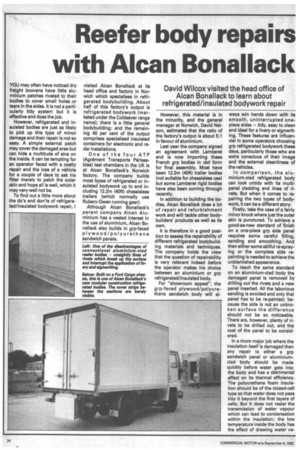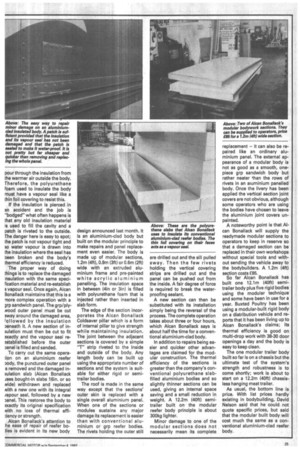Reefer body repairs with Akan BonaHack
Page 18

Page 19

If you've noticed an error in this article please click here to report it so we can fix it.
David Wilcox visited the head office of Alcan Bonallack to learn about refrigerated/insulated bodywork repair
YOU may often have noticed dry freight boxvans have little aluminium patches riveted to their bodies to cover small holes or tears in the sides. It is not a particularly tidy system but it is effective and does the job.
However, refrigerated and insulated bodies are just as likely to pick up this type of minor damage and their repair is not so easy. A simple external patch may cover the damaged area but can hide a multitude of sins on the inside. It can be tempting for an operator faced with a costly repair and the loss of a vehicle for a couple of days to ask his fitter merely to patch the outer skin and hope all is well, which it may very well not be.
To find out a little more about the do's and don'ts of refrigerated/insulated bodywork repair, visited Alcan Bona'lack at its head office and factory in Norwich which specialises in refrigerated bodybuilding. About half of this factory's output is refrigerated bodywork (marketed under the Coldsaver range name); there is a little general bodybuilding; and the remaining 40 per cent of the output cornprises specialised insulated containers for electronic and radar installations.
One of the four ATP (Agrement Transports Parissables) test chambers in the UK is at Alcan Bonallack's Norwich factory. The company builds most types of refrigerated or insulated bodywork up to and including 12.2m (40ft) chassisless trailers (which normally use Rubery-Owen running gear).
Although Alcan Bonallack's parent company Alcan Aluminium has a vested interest in the use of aluminium, Alcan Bonallack also builds in grp-faced plywood/polyurethane sandwich panels, However, this material is in the minority, and the general manager at Norwich, David Nelson, estimated that the ratio of the factory's output is about 5:1 in favour of aluminium.
Last year the company signed an agreement with Lamberet and is now importing these French grp bodies in ckd form for final assembly. Most have been 12.2m (40ft) trailer bodies (not suitable for chassisless use) but some Lamberet rigid bodies have also been coming through recently.
In addition to building the bodies, Alcan Bonallack does a lot of repair and refurbishment work and will tackle other bodybuilders' products as well as its own.
It is therefore in a good position to assess the repairability of different refrigerated bodybuilding materials and techniques. The company holds the view that the question of repairability is very relevant indeed before the operator makes his choice between an aluminium or grp refrigerated/insulated body.
For "showroom appeal", the grp-faced plywood/polyurethane sandwich body will al ways win hands down with its smooth, uninterrupted onepiece sides — tidy, easy to clean and ideal for a livery or signwriting. These features are influendal in some operators choosing grp refrigerated bodywork these days, particularly those who are extra conscious of their image and the external cleanliness of the vehicles.
In comparison, the aluminium-clad refrigerated body can look untidy with its multipanel cladding and lines of rivets. But when it comes to repairing the two types of bodywork, it can be a different story.
Firstly, take the case of a fairly minor knock where just the outer skin is punctured. To achieve a good-as-new standard of finish on a one-piece grp side panel requires some careful filling, sanding and smoothing. And then either some skilful re-spraying or the complete side repainting is needed to achieve the unblemished appearance.
To reach the same standard on an aluminium-clad body the damaged panel is removed by drilling out the rivets and a new panel inserted. All the laborious sanding is avoided and only that panel has to be re-painted; because the side is not an unbroken surface the difference should not be so noticeable. There are, however, plenty of rivets to be drilled out, and the cost of the panel to be considered.
In a more major job where the insulation itself is damaged then any repair to either a grp sandwich panel or aluminiumclad body should be made quickly before water gets into the body and has a detrimental effect on its thermal efficiency. The polyurethane foam insulation should be of the closed-cell type so that water does not pass into it beyond the first layers of cells. But it does not resist the transmission of water vapour which can lead to condensation within the insulation; the low temperature inside the body has the effect of drawing water va pour through the insulation from the warmer air outside the body. Therefore, the polyurethane roam used to insulate the body must have a vapour seal like a thin foil covering to resist this.
If the insulation is pierced in an accident and the job is "bodged" what often happens is that any old insulation material is used to fill the cavity and a patch is riveted to the outside. The danger here is easy to spot; the patch is not vapour tight and so water vapour is drawn into the insulation where the seal has been broken and the body's thermal efficiency is reduced.
The proper way of doing things is to replace the damaged insulation with the same specification material and re-establish 9 vapour seal. Once again, Alcan Bonallack maintains that this is a more complex operation with a grp sandwich panel. The grp/plyNood outer panel must be cut away around the damaged area, followed by the insulation aeneath it. A new section of insulation must then be cut to fit 3xactly and the vapour Seal re3stablished before the outer Dan& is filled and sanded.
To carry out the same operation on an aluminium reefer aody, the punctured outer panel $ removed and the damaged insulation slab (Alcan Bonallack Jses bought-in slabs 16in. or so Nide) withdrawn and replaced Nith a new one with its integral rapour seal, followed by a new panel. This restores the body to )xactly its original specification Nith no loss of thermal effiAency or strength.
Alcan Bonallack's attention to he ease of repair of reefer bohes is evident in its new body design announced last month. It is an aluminium-clad body but built on the modular principle to make repairs and panel replacement even easier. The body is made up of modular sections, 1.2m (4ft), 0.9m (3ft) or 0.6m (2ft) wide with an extruded aluminium frame and pre-painted white acrylic aluminium panelling. The insulation space in between (4in or 3in) is filled with polyurethane foam that is injected rather than inserted in slab form.
The edge of the section incorporates the Alcan Bonallack Coldsaver pillar which is a form of internal pillar to give strength while maintaining insulation. The joint between the adjacent sections is covered by a simple "T" strip riveted to the inside and outside of the body. Any length body can be built up using the appropriate number of sections and the system is suitable for either rigid or semitrailer bodies.
The roof is made in the same way except that the sections' outer skin is replaced with a single overall aluminium panel. When one of the sections or modules sustains any major damage its replacement is easier than with conventional aluminium or grp reefer bodies. The rivets holding the outer still are drilled out and the sill pulled away. Then the few rivets holding the vertical covering strips are drilled out and the panel can be pushed out from the inside. A fair degree of force is required to break the waterproofing sealant.
A new section can then be substituted with its installation simply being the reversal of the process. The complete operation takes about three or four hours, which Alcan Bonallack says is about half the time for a conventional aluminium-clad body.
In addition to repairs being easier and quicker other advantages are claimed for the modular construction. The thermal efficiency of the sections is greater than the company's conventional polyurethane slabfilled aluminium bodies and so slightly thinner sections can be used, giving an internal space saving and a small reduction in weight. A 12.2m (40ft) semitrailer built on the modular reefer body principle is about 300kg lighter.
Minor damage to one of the modular sections does not necessarily mean its complete replacement — it can also be repaired like an ordinary aluminium panel. The external appearance of a modular body is not as good as a smooth, onepiece grp sandwich body but rather neater than the rows of rivets in an aluminium panelled body. Once the livery has been applied the vertical section joint covers are not obvious, although some operators who are using the bodies have chosen to leave the aluminium joint covers unpainted. A noteworthy point is that Alcan Bonallack will supply the readymade modular sections to operators to keep in reserve so that a damaged section can be replaced in their own workshops without special tools and without sending the vehicle away to the bodybuilders. A 1.2m (4ft) section costs £85.
So far Alcan Bonallack has built one 12.1m (40ft) semitrailer body plus five rigid bodies using the modular technique and some have been in use for a year. Buxted Poultry has been using a modular-built rigid body on a distribution vehicle and reports that it has been living up to Alcan Bonallack's claims; its thermal efficiency is good on multi-drop work with 38-30 door openings a day and the body is easy to keep clean.
The one modular trailer body built so far is on a chassis but the ultimate test of the system's strength and robustness is to come shortly; work is about to start on a 12.2m (40ft) chassisless hanging meat trailer.
As usual, the bottom line is price. With list prices hardly existing in bodybuilding, David Nelson said that he could not quote specific prices, but said that the modular built body will cost much the same as a conventional aluminium-clad reefer body.




















































